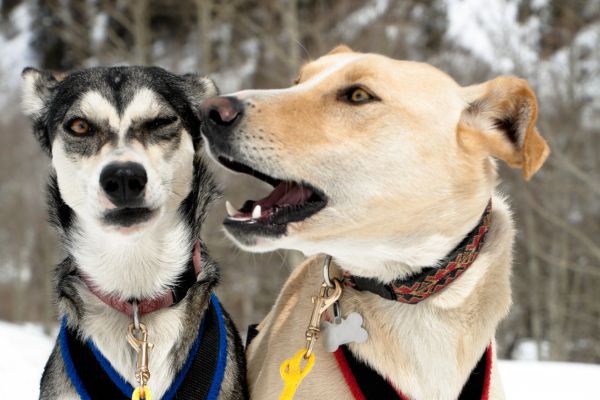Animal communication is fascinating, encompassing various forms and meanings. Discover how animals communicate in surprising ways.
Visual Signals in Animal Communication

Visual signals are fundamental in animal communication. Many animals use body postures, colors, and movements to convey messages. For example, birds display colorful feathers during mating to attract partners. Additionally, certain reptiles change color to show aggression or submission. Animal communication, therefore, is rich and varied.
Another example is the alert behavior of dogs. They raise their ears and focus their attention to indicate that something has caught their attention. This demonstrates that visual animal communication is efficient and immediate. Therefore, understanding these signals helps owners interpret their pets’ behavior, improving coexistence.
Finally, facial expressions are crucial in animal communication, especially in primates. Smiles, grimaces, and gazes convey a wide range of emotions. Understanding these signals can prevent misunderstandings and strengthen the bond with the animal. Thus, animal communication through visual signals is complex and essential for effective interaction between species.
Sound Signals in Animal Communication

Sound signals are another important form of animal communication. Many animals use vocalizations to express themselves. For example, birds sing to mark territory and attract partners. Additionally, dogs bark to alert about dangers or to get the owner’s attention. Animal sound communication is, therefore, very effective.
Moreover, cats use meows to communicate needs and feelings. Each type of meow can indicate hunger, desire for attention, or discomfort. Understanding these vocalizations helps owners respond appropriately to the animal’s needs. Thus, animal sound communication is vital for a good relationship between pet and owner.
Finally, whales and dolphins use complex sounds to navigate and interact socially. These sound signals are essential for the group’s survival and cohesion. Therefore, studying animal sound communication reveals the depth and complexity of interactions among animals. It is a fascinating field that continues to surprise researchers.
Animal Communication: Use of Pheromones

Pheromones are a silent form of animal communication. Many animals release chemical substances to transmit specific information. For example, ants use pheromones to indicate the location of food. This animal communication is invisible but extremely effective and precise.
Additionally, cats use facial pheromones to mark territory. Rubbing their faces on objects releases these substances, creating a familiar and safe environment. This shows how animal communication can be subtle but very important for well-being. Understanding this behavior helps owners provide a more comfortable environment for their pets.
Finally, pheromones are also used in mating rituals. Many insects and mammals release these substances to attract partners. This chemical animal communication is crucial for the reproduction and survival of species. Therefore, studying pheromones reveals a fascinating and essential dimension of animal interaction.
Importance of Gestures in Animal Communication

Gestures play an important role in animal communication. Many animals use specific movements to express intentions and feelings. For example, dogs wag their tails to show joy and excitement. This facilitates understanding between the animal and the owner, improving interaction.
Additionally, primates use complex gestures to communicate. Extended hands can indicate requests for help or affection. These gestures are fundamental for social cohesion and conflict resolution. Understanding this animal communication helps to better understand the emotional needs of animals.
Finally, birds use wing and head movements to convey messages. These gestures can signal aggression, submission, or courtship. Thus, gestures are a crucial form of animal communication, allowing rich and meaningful interaction between different species. Studying these behaviors enriches our understanding of animal life.
Olfactory Communication Among Animals

Olfactory communication is essential in the animal kingdom. Many animals rely on smell to transmit vital information. For example, dogs sniff to identify friends, enemies, and potential partners. Animal olfactory communication is, therefore, fundamental for socialization and survival.
Moreover, many animals mark territory with urine or other secretions. This behavior helps establish boundaries and avoid confrontations. Understanding these olfactory signals is crucial for understanding social dynamics among animals. Therefore, animal communication through smell is a powerful and efficient form of interaction.
Finally, insects like bees use olfactory signals to coordinate activities within the hive. Pheromones are released to indicate the location of food and to warn about dangers. Animal olfactory communication is thus a sophisticated and vital means of information transmission. Studying this form of communication reveals the complexity of animal interactions.
Tactile Signals in Animal Communication
Tactile signals are fundamental in animal communication. Many animals use touch to express emotions and intentions. For example, cats use physical contact to show affection and security. This type of animal communication is essential for strengthening bonds between animals and humans.
Additionally, primates use grooming, or mutual cleaning, to establish and maintain social relationships. This behavior reduces stress and promotes group cohesion. Animal tactile communication is, therefore, crucial for social stability and the emotional well-being of animals. Understanding these signals helps improve interaction with pets.
Finally, animals like elephants use gentle touches with their trunks to communicate. This behavior can express comfort, affection, or even alertness to dangers. Thus, animal communication through touch is a powerful form of emotional expression. Studying these signals enriches our understanding of animal relationships.
Animal Communication: Use of Facial Expressions
Facial expressions are an important form of animal communication. Many animals use facial movements to convey emotions. For example, dogs raise their eyebrows to show curiosity or concern. This animal communication is immediate and easily recognizable by humans.
Moreover, primates are known for their complex facial expressions. Smiles, grimaces, and looks communicate a wide range of feelings and intentions. These expressions are fundamental for social cohesion and conflict resolution. Understanding animal facial communication helps interpret animal behavior better.
Finally, birds also use facial expressions, although more subtly. Beak and eye movements can indicate aggression, curiosity, or submission. Thus, facial expressions are a crucial form of animal communication. Studying these facial signals offers a deep insight into the emotional interactions among animals.
Body Language in Animal Communication
Body expressions play a crucial role in animal communication. Many animals use specific postures and movements to convey messages. For example, cats arch their backs and fluff their fur to appear larger and more threatening. This animal communication is an effective defense.
Additionally, dogs use a variety of body expressions. Lowered ears, tail between the legs, and a hunched posture indicate fear or submission. Conversely, a relaxed posture and wagging tail signal happiness and confidence. Understanding these body expressions is essential for good coexistence.
Finally, horses use body and tail movements to communicate. A wagging tail can indicate irritation, while ears laid back signal alertness or aggression. Thus, animal communication through body expressions is a rich and varied form of interaction. Studying these behaviors helps to understand the needs and emotions of animals better.
Animal Communication: Body Posture Language
Body posture language is vital in animal communication. Many animals use specific postures to convey clear messages. For example, dogs assume an alert posture with a tense and focused body. This animal communication indicates that something has caught their attention.
Moreover, cats use body postures to communicate emotions. A relaxed cat will have a loose posture, while a frightened cat will arch its back. Understanding these postures helps owners interpret their pet’s emotional state. Thus, animal communication through body posture is essential for good interaction.
Finally, birds like parrots use the position of their wings and feathers to express emotions. Raised wings can indicate aggression or excitement, while flattened feathers indicate relaxation. Animal communication through body posture is, therefore, an effective way to convey intentions and feelings. Studying these signals improves our understanding of animals.
Animal Communication: Understanding Animal Behavior
Understanding animal behavior is crucial for good animal communication. Many animals use specific behaviors to transmit information. For example, dogs roll on their backs to show submission. This behavior is an effective way to avoid conflicts.
Moreover, cats have distinct behaviors to indicate different states. A cat kneading with its paws is comfortable and happy. Understanding these behaviors helps owners better respond to their pets’ needs. Thus, animal communication through behavior is essential for harmonious coexistence.
Finally, birds exhibit a variety of behaviors to communicate. Head movements and singing can indicate joy or territory. Studying these behaviors reveals the complexity of animal communication. Therefore, understanding animal behavior improves interaction and the bond between humans and pets.
Conclusion: The Fascinating Animal Communication
Animal communication is a fascinating and complex area, filled with visual, auditory, olfactory, and tactile signals. Understanding these different modes of animal communication helps owners interact more effectively with their pets. For example, recognizing visual and auditory signals can improve the response to animals’ emotional and physical needs.
Moreover, studying chemical animal communication, such as the use of pheromones, reveals a deeper layer of interaction. Many animals use these invisible signals to transmit important messages. Animal communication through touch also plays a vital role in establishing bonds and reducing stress. Thus, each form of communication contributes to social cohesion and animal well-being.